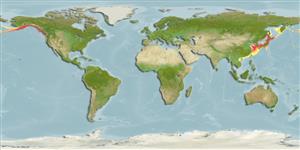Common names from other countries
Teleostei (teleosts) >
Perciformes/Cottoidei (Sculpins) >
Agonidae (Poachers) > Hemitripterinae
Etymology: Hemitripterus: Greek, hemi = half + Greek, tres, tria = three + Greek, pteron = wing, fin (Ref. 45335).
More on author: Pallas.
Environment: milieu / climate zone / depth range / distribution range
Ecology
Marine; demersal; depth range 0 - 550 m (Ref. 50550). Temperate; 66°N -
Northwest Pacific: Karaginskiy and Commander islands, Bering Sea to Okhotsk and Japan seas; one record from the western Gulf of Alaska.
Size / Weight / Age
Maturity: Lm ? range ? - ? cm
Max length : 35.0 cm SL male/unsexed; (Ref. 559)
Short description
Identification keys | Morphology | Morphometrics
Dorsal spines (total): 17 - 19; Dorsal soft rays (total): 11 - 13; Anal spines: 0; Anal soft rays: 12 - 15. Body covered with many small tubercles; head large, with numerous bony humps and ridges; spinous dorsal fin deeply emarginate, its base longer than that of the soft dorsal fin; jaws, prevomer and palatines with broad bands of conical teeth (Ref. 559).
Life cycle and mating behavior
Maturities | Reproduction | Spawnings | Egg(s) | Fecundities | Larvae
Spawn in the calcareous deposits of colonies of the polychaeta, Salmacinasp. which makes them more of 'cavity spawners' than 'spawners in live vertebrate' (Ref. 34819, 26281).
Eschmeyer, W.N., E.S. Herald and H. Hammann, 1983. A field guide to Pacific coast fishes of North America. Boston (MA, USA): Houghton Mifflin Company. xii+336 p. (Ref. 2850)
IUCN Red List Status (Ref. 130435)
CITES (Ref. 128078)
Not Evaluated
Threat to humans
Harmless
Human uses
Tools
Special reports
Download XML
Internet sources
Estimates based on models
Preferred temperature (Ref.
115969): 0.9 - 11, mean 4.7 (based on 411 cells).
Phylogenetic diversity index (Ref.
82804): PD
50 = 0.6289 [Uniqueness, from 0.5 = low to 2.0 = high].
Bayesian length-weight: a=0.01096 (0.00493 - 0.02437), b=3.06 (2.86 - 3.26), in cm Total Length, based on LWR estimates for this species & (Sub)family-body (Ref.
93245).
Trophic level (Ref.
69278): 4.3 ±0.4 se; based on diet studies.
Resilience (Ref.
120179): Low, minimum population doubling time 4.5 - 14 years (Preliminary K or Fecundity.).
Fishing Vulnerability (Ref.
59153): Low to moderate vulnerability (33 of 100).
